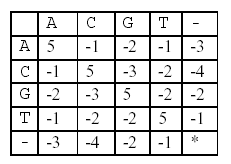POJ 1080 Human Gene Functions -- 动态规划(最长公共子序列)
题目地址:http://poj.org/problem?id=1080
Description
their functions, because these can be used to diagnose human diseases and to design new drugs for them.
A human gene can be identified through a series of time-consuming biological experiments, often with the help of computer programs. Once a sequence of a gene is obtained, the next job is to determine its function.
One of the methods for biologists to use in determining the function of a new gene sequence that they have just identified is to search a database with the new gene as a query. The database to be searched stores many gene sequences and their functions – many
researchers have been submitting their genes and functions to the database and the database is freely accessible through the Internet.
A database search will return a list of gene sequences from the database that are similar to the query gene.
Biologists assume that sequence similarity often implies functional similarity. So, the function of the new gene might be one of the functions that the genes from the list have. To exactly determine which one is the right one another series of biological experiments
will be needed.
Your job is to make a program that compares two genes and determines their similarity as explained below. Your program may be used as a part of the database search if you can provide an efficient one.
Given two genes AGTGATG and GTTAG, how similar are they? One of the methods to measure the similarity
of two genes is called alignment. In an alignment, spaces are inserted, if necessary, in appropriate positions of
the genes to make them equally long and score the resulting genes according to a scoring matrix.
For example, one space is inserted into AGTGATG to result in AGTGAT-G, and three spaces are inserted into GTTAG to result in –GT--TAG. A space is denoted by a minus sign (-). The two genes are now of equal
length. These two strings are aligned:
AGTGAT-G
-GT--TAG
In this alignment, there are four matches, namely, G in the second position, T in the third, T in the sixth, and G in the eighth. Each pair of aligned characters is assigned a score according to the following scoring matrix.
denotes that a space-space match is not allowed. The score of the alignment above is (-3)+5+5+(-2)+(-3)+5+(-3)+5=9.
Of course, many other alignments are possible. One is shown below (a different number of spaces are inserted into different positions):
AGTGATG
-GTTA-G
This alignment gives a score of (-3)+5+5+(-2)+5+(-1) +5=14. So, this one is better than the previous one. As a matter of fact, this one is optimal since no other alignment can have a higher score. So, it is said that the
similarity of the two genes is 14.
Input
The length of each gene sequence is at least one and does not exceed 100.
Output
Sample Input
2
7 AGTGATG
5 GTTAG
7 AGCTATT
9 AGCTTTAAA
Sample Output
14
21
#include <stdio.h>
int matrix[5][5] = {
{5, -1, -2, -1, -3},
{-1, 5, -3, -2, -4},
{-2, -3, 5, -2, -2},
{-1, -2, -2, 5, -1},
{-3, -4, -2, -1, 0},
};
char exchange[5] = {'A', 'C', 'G', 'T', ' '};
//通过矩阵求每一对字符的分值
int Value (char m, char n){
int R, C;
int i;
for (i=0; i<5; ++i){
if (exchange[i] == m)
R = i;
if (exchange[i] == n)
C = i;
}
return matrix[R][C];
}
int Max (int a, int b, int c){
int max = (a > b) ? a : b;
return (max > c) ? max : c;
}
int Similarity (char str1[], int length1, char str2[], int length2){
int dp[110][110];
int i, j;
dp[0][0] = 0;
for (i=1; i<=length1; ++i)
dp[i][0] = dp[i-1][0] + Value (str1[i], ' ');
for (i=1; i<=length2; ++i)
dp[0][i] = dp[0][i-1] + Value (' ', str2[i]);
///////////////////////////////////////////////////////////////////////////
//dp[i][j]表示第一个字串的长为i的子串与第二个字串的长为j的子串的相似度
for (i=1; i<=length1; ++i){
for (j=1; j<=length2; ++j){
///////////////////////////////////////////////////////////////////
//状态转移方程
if (str1[i] == str2[j]){
dp[i][j] = dp[i-1][j-1] + Value (str1[i], str2[j]);
}
else{
dp[i][j] = Max (dp[i-1][j] + Value (str1[i], ' '),
dp[i][j-1] + Value (' ', str2[j]),
dp[i-1][j-1] + Value (str1[i], str2[j]));
}
///////////////////////////////////////////////////////////////////
}
}
///////////////////////////////////////////////////////////////////////////
return dp[length1][length2];
}
int main(void){
char str1[110];
char str2[110];
int length1;
int length2;
int T;
int ans;
while (scanf ("%d", &T) != EOF){
while (T-- != 0){
scanf ("%d%s", &length1, str1 + 1);
scanf ("%d%s", &length2, str2 + 1);
if (length1 > length2)
ans = Similarity (str1, length1, str2, length2);
else
ans = Similarity (str2, length2, str1, length1);
printf ("%d\n", ans);
}
}
return 0;
}
HDOJ上相似的题目:http://acm.hdu.edu.cn/showproblem.php?pid=1513
POJ 1080 Human Gene Functions -- 动态规划(最长公共子序列)的更多相关文章
- poj 1080 ——Human Gene Functions——————【最长公共子序列变型题】
Human Gene Functions Time Limit: 1000MS Memory Limit: 10000K Total Submissions: 17805 Accepted: ...
- poj 1080 Human Gene Functions (最长公共子序列变形)
题意:有两个代表基因序列的字符串s1和s2,在两个基因序列中通过添加"-"来使得两个序列等长:其中每对基因匹配时会形成题中图片所示匹配值,求所能得到的总的最大匹配值. 题解:这题运 ...
- poj 1080 Human Gene Functions(lcs,较难)
Human Gene Functions Time Limit: 1000MS Memory Limit: 10000K Total Submissions: 19573 Accepted: ...
- dp poj 1080 Human Gene Functions
题目链接: http://poj.org/problem?id=1080 题目大意: 给两个由A.C.T.G四个字符组成的字符串,可以在两串中加入-,使得两串长度相等. 每两个字符匹配时都有个值,求怎 ...
- poj 1080 Human Gene Functions(dp)
题目:http://poj.org/problem?id=1080 题意:比较两个基因序列,测定它们的相似度,将两个基因排成直线,如果需要的话插入空格,使基因的长度相等,然后根据那个表格计算出相似度. ...
- POJ 1080 Human Gene Functions 【dp】
题目大意:每次给出两个碱基序列(包含ATGC的两个字符串),其中每一个碱基与另一串中碱基如果配对或者与空串对应会有一个分数(可能为负),找出一种方式使得两个序列配对的分数最大 思路:字符串动态规划的经 ...
- POJ 1080 Human Gene Functions
题意:给两个DNA序列,在这两个DNA序列中插入若干个'-',使两段序列长度相等,对应位置的两个符号的得分规则给出,求最高得分. 解法:dp.dp[i][j]表示第一个字符串s1的前i个字符和第二个字 ...
- HDU 1080 Human Gene Functions--DP--(变形最长公共子)
意甲冠军:该基因序列的两端相匹配,四种不同的核苷酸TCGA有不同的分值匹配.例如T-G比分是-2,它也可以被加入到空格,空洞格并且还具有一个相应的核苷酸匹配分值,求最大比分 分析: 在空气中的困难格的 ...
- POJ 1458 Common Subsequence(LCS最长公共子序列)
POJ 1458 Common Subsequence(LCS最长公共子序列)解题报告 题目链接:http://acm.hust.edu.cn/vjudge/contest/view.action?c ...
随机推荐
- Chart控件的多种使用方法
花了近一周时间专门研究.net 3.5平台提供的Chart控件的使用方法,感觉该控件的功能很强大,做出的图表效果也很美观,使用方法也并不复杂.如今先讲下Chart控件的部署及一些基本使用方法. 一.安 ...
- iOS开发——UI篇&提示效果
提示效果 关于iOS开发提示效果是一个很常见的技术,比如我们平时点击一个按钮,实现回馈,或者发送网络请求的时候! 技术点: 一:View UIAlertView UIActionSheet 二:控制器 ...
- HDU 3157 Crazy Circuits(有源汇上下界最小流)
HDU 3157 Crazy Circuits 题目链接 题意:一个电路板,上面有N个接线柱(标号1~N),还有两个电源接线柱 + -.给出一些线路,每一个线路有一个下限值求一个能够让全部部件正常工作 ...
- 内核日志及printk结构浅析
作者:tekkamanninja 鸣谢:感谢ChinaUnix技术社区的tekkamanninja提供稿件 ,如需转载,请注明出处. 这段时间复习了一下内核调试系统,注意看了一下printk的实现 ...
- ibdata文件增大的原因
http://blog.itpub.net/22664653/viewspace-1994016/
- Tomcat配置域名访问
在server.xml文件中的<Host>标签里面添加 <Alias>你的域名(比如:www.baidu.com)</Alias> <Context path ...
- Fortify规则与CERT JAVA 安全编程规范的对照表
Fortify规则与CERT JAVA 安全编程规范的对照表http://www.automationqa.com/forum.php?mod=viewthread&tid=4353& ...
- 基于嵌入式的c语言连接器
一个C程序可能是由多个分别编译的部分组成,这些不同部分通过一个通常叫做链接器(或连接器,载入器)的程序合并成一个整体.因为编译器一般每次只处理一个文件,所以它不能检测出那些需要一次了解多个源程序文 ...
- Nodejs v4.x.0API文档学习(1)简介
文档参考地址:https://nodejs.org/dist/latest-v4.x/docs/api/ 简介 下面是用nodejs编写的一个web服务的例子,返回"Hello World& ...
- C#实现快速排序法
现在有数组{ 3, 6, 2, 1, 9, 5, 4, 7 }; 然后用快速排序法把他们排序 1.首先 ,取出3作为比较数据 2.从最右边往左边比较找到第一个比3小的数据,把3在数组中的位置赋值为那个 ...
